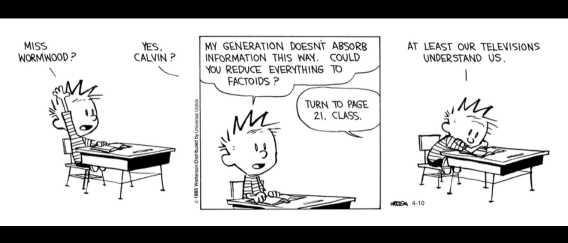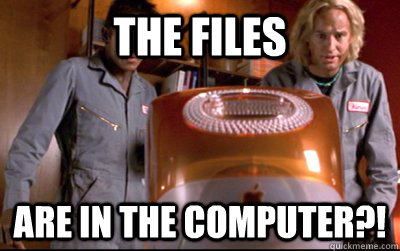Gimmick
or Tool?
For my district I grew up in when
you entered the fourth grade you went to a new building and new placement. When
entering the new school there was a special program that was called T.R.E.E. at
the time I didn’t know what the acronym stood for and all I can recall now is
that it was Technology, research, enrichment and I have no idea what the last
“e” was. Considering the first part of the acronym to be technology they must
have put a high value on it and looking back and comparing the program I was in
and the experience of the average fourth through sixth grader in my district I
defiantly got a different education.
The program did make me an expert
PowerPoint maker but more importantly it did start the seeds of how to become a
great researcher. The type of instruction that I got on how to evaluate a
source wasn’t given to my other peers till high school. This gap of digital
literacy wasn’t as bad or detrimental to the students as not being exposed to
reading until five years after pre-school but it did show in the presentations
that were given in high school. You would see students having slides with black
font on a really dark background, ineffective transitions, or paragraphs on the
slides instead of bullet points. The worst would be a claim that was from an
unreliable source that leads to a very questionable point. Educating student on
how to navigate information is very important lesson that we as educators can
pass on. Just as important the tools we use.

Back
to when I was a cute fourth grader, we had smart boards for each grade level.
Just keep in mind I was in the fourth grade in 2000, smart boards were brand
new and there was very little professional support for the gadget. The teachers
would attempt to use the smart board in the classroom but something always went
wrong may it be that smart board freezing up or the lesson plan became more
about the gadget than the content. In my eyes the smart board was very much a
gadget rather than a tool for education. This belief was later supported by the
fact that in my high school every room was fitted with one but rarely was it
ever used for other than a screen for the projector. It wasn't until my
sophomore year of college nearly a decade later did I see the smart board used
to promote the content in the classroom. I was amazed by how great it worked
with the students and in tandem with the ELMO devices it is a main stay for
most teachers these days.

The smart board debacle still sticks
in my head as a case of technology for technology sake then actually advancing
the class. It either took a decade for the technology to become bug free or it
took a decade for educators to catch up to the technology. Either statement shows
that adopting technology is a very high financial burden for a school. With all
of this said in class we have talked about free tools that can provided the
same desired results as an expensive alternative. The Animoto program is a
great way for teachers and students to make a presentation or introduce a
topic. Similar programs like Animoto, offer a very low risk to educators while
offering new ways of presenting “old” content. It will be interesting to see
how technology changes the classroom in the coming years.

That is such a wonderful opportunity you had to attend such a technologically advanced school!! I really like that you emphasize how it's influenced your use and interest in using computer programs and research. I definitly chuckled to myself a couple times reading your post (for example, not knowing what the last E stands for, and the Zoolander reference). While it's wonderful that your classrooms had Smart boards, it is very honest of you and observant, to admit they didn't really get used much (not until college, ha!) I agree with you that while some technologies have appropriate uses (times, age of students, etc.), others can seem like a hinderance or even just unnecessary. Hopefully now that the teachers have had them in their classrooms for a couple of years, they're getting more use out of them.
ReplyDeleteIt's interesting to hear your comparison of students who were privelged to receive that early introduction to technology, and those who didn't even us PowerPoint until high school. What is most fascinating is that not only did their overall presentation not visually match those of yours, but their sources were unreliable, indicating their research abilities had not been developed yet, or that they weren't taught how to research at all. Technology really had made our generations smarter and smarter, but it's so sad to know that it has innately created a gap between the priveleged and the not so priveleged.
I once read a summary of a study that compared that digital presentations and video lessons to actual in-class lessons. They found that in math and science especially, it was easier to follow the lesson with an actual teacher writing the material on the board. It was easier to follow the human pointing to different portions of the board.
ReplyDeleteThis was compared to a digital lesson, where the speed wasn't limited to how fast a person could write on the board, so it made writing notes and keeping up more difficult as the lesson was either prerecorded or most of the information was put in ahead of time. The other part was that because there was no person pointing to information, it was hard to relate to a faceless cursor pointing to information,so the lesson was harder to follow.
I think I fall in somewhere between the two arguments, while digital classroom tools like the ones Paul talked about certainly make some of the tasks easier, we have to be cognizant of the real effect it has in the classroom, and if it's the most effective method. We've all seen the lessons where the teacher labors to draw a shape in a ink marker tool on smart board, when it would've taken seconds with actual chalk..